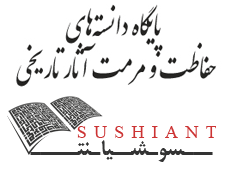یاسر حمزوی
معرفی تزئینات گچی بناهای دورهی تیموری شهر یزد و فنشناسی تزئینات گچی بقعهی ستیفاطمه (قرن ۹ هـ.ق﴾
پایاننامهی کارشناسی ارشد،
دانشگاه هنر اصفهان (دانشکدهی حفاظت و مرمت)، ۱۳۸۸
استاد راهنما: حسام اصلانی
استاد مشاور: غلامرضا وطنخواه
چکیده:
بقعهی ستی فاطمه از برجستهترین آثار دوره تیموری در شهر تاریخی یزد می باشد که گفته می شود توسط ستی فاطمه خاتون (همسر امیر چخماق) در قرن نهم هجری بنا شده است. تزئینات گچی داخل بنا چه به لحاظ تاریخی و چه از نظر فنی منحصر بفرد بنظر میرسد. تنگبریها و قاببندیهای این بنا با ظرافت خاصی اجرا شده ولی متاسفانه بیشتر قسمتهای تزئینات گچی در زیر اندودهای گچی مربوط به تعمیرات قبلی پنهان شده و آسیب فراوانی بر این تزئینات وارد شده است. ….. این پژوهش اهدافی را دنبال می کند که از جمله آنها : بررسی، مطالعه و شناخت تزئینات گچی بناهای هم عصر این بقعه و مطالعه تحلیلی و تطبیقی آن و همچنین شناسایی نوع مواد بکار رفته در تزئینات گچی این بنا، بررسی و شناخت فن و نحوه اجرای این تزئینات و در پایان ارایه توصیه های لازم برای جزییات فنی در طرح مرمت این تزئینات با تکیه بر نتایج حاصله در مطالعات فنشناسی این پایاننامه میباشد. …. در این پژوهش سعی شده است که ابتدا گردآوری دادهها (مطالعات میدانی، اینترنتی و کتابخانهای) صورت گیرد و سپس با اطلاعات و نمونه برداری دقیقتر مطالعات آزمایشگاهی (استفاده از آنالیزهای شیمیایی، لایهنگاری و بررسیهای میکروسکوپی) انجام گیرد و در پایان، تحلیل داده ها و نتیجه گیری از آن صورت پذیرد. پس از انجام کلیه مراحل پژوهش به نتایج ارزندهای در مورد فنشناسی تزئینات گچی بقعه ستی فاطمه دست یافتیم؛ هنگام ساخت بنا جهت اجرای تزئینات مقداری خاک و آهک به ملاط گچ افزوده شده است. مواد آلی در ترکیب ملاط وجود ندارد. بیشتر تزئینات گچی بصورت قالبی ساخته شده و در محل مورد نظر نصب گردیده و جهت ایستایی بیشتر تزئینات گچی قالبی، هنگام ساخت، از گیاه نی یا تخته گچی در درون ملاط استفاده شده است.
Abstract: Setti-Fatemeh Mausoleum is one of the most distinguished Timurid’s artworks in historic city of Yazd/Iran which is known to be built by order of Setti-Fatemeh Khatoon (Amir Chakhmagh’s wife). Gypsum stucco decorations inside the building are unique from technical and historical view point. Tongboris and casings are executed very finely but unfortunately most of the decorations are hidden under previous treatments and have cause a lot of damages to them. Due to specific characterizations of the decorations and also the need for starting conservation and restoration of them, it was necessary to identify the construction materials and how they have been executed and then make decisions about conservation and restoration procedures. Main goals of this research are investigating and identifications of gypsum stucco decorations of the same period of this mausoleum and comparative analytical study to understand technical information about their execution and finally proposing a conservation plan based on the obtained results. It seems that execution of the casings in the decorations is done by normal gypsum and it has to be considered in conservation treatments. In this research after a comprehensive literature survey, an appropriate sampling was done for chemical analysis ad microscopic investigations. Finally the data was analyzed and conclusions made accordingly.The results showed that in execution of the decorations a little clay and lime were added to the gypsum mortar. No traces of organic materials were observed. Most of the decorations are executed by casting first and then installation in their place. For better sustainability of the casting decorations, plant straw or gypsum pieces in mortar during the execution.
